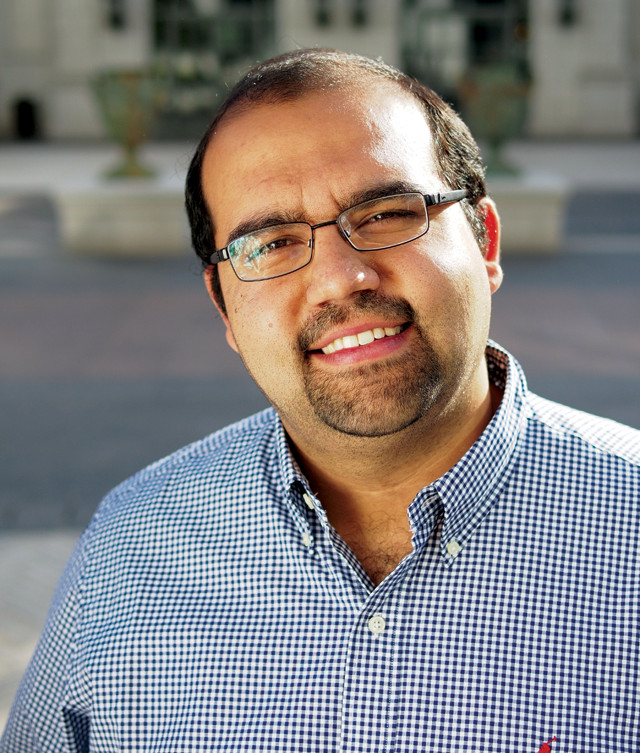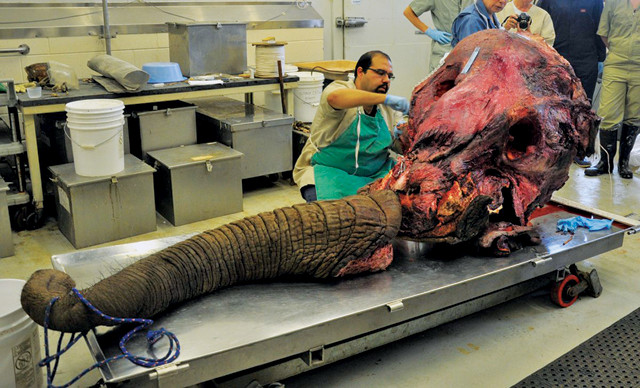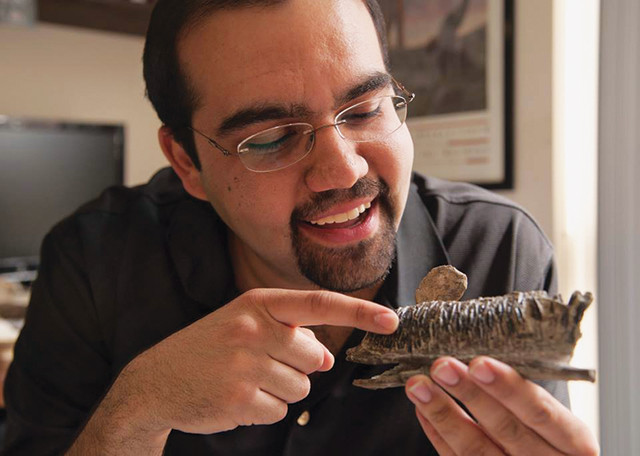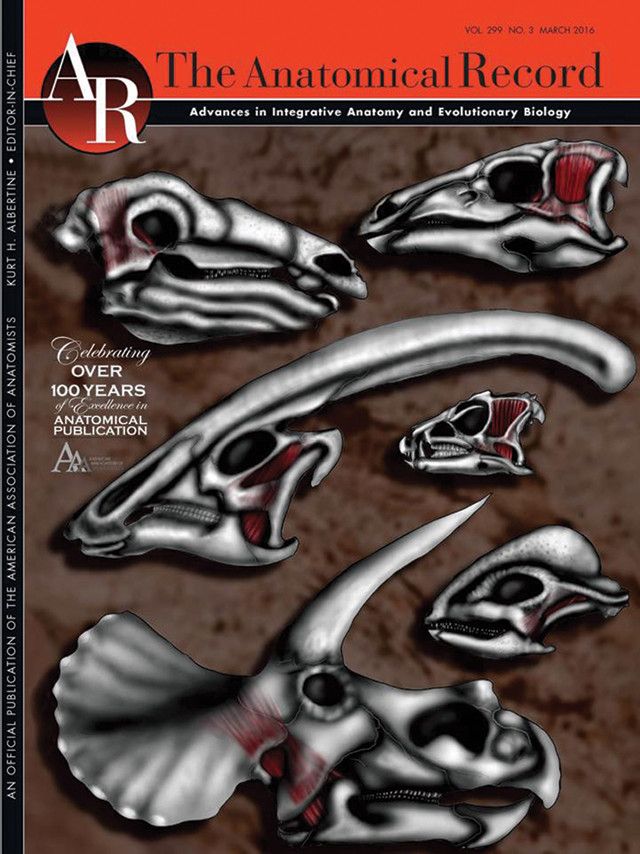
by Thea Boodhoo Monday, December 11, 2017

Anatomist and paleontologist Ali Nabavizadeh is an assistant professor at Cooper Medical School of Rowan University in Camden, N.J. Credit: Thea Boodhoo.
A perfect day in the life of paleontologist Ali Nabavizadeh wouldn’t be complete without a fresh corpse. The subjects of his work at the dissection table range from a rhinoceros, to an elephant head, to the human cadavers essential to the anatomy classes he teaches at Cooper Medical School of Rowan University in Camden, N.J. The only thing that could possibly top a fresh corpse, in fact, is an extremely old one.
Nabavizadeh’s focus on the anatomy of living animals gives him a perspective on the lives and relationships of dinosaurs that other paleontologists might not have. To get an idea of how an anatomist approaches paleontology, I asked for his thoughts on the controversial March 2017 proposal from Matthew Baron at the University of Cambridge in England. Baron and his team suggest overturning the century-old family tree that puts theropods like Tyrannosaurus in the same group as sauropods like Brachiosaurus, proposing instead that theropods are actually more closely related to ornithischians — the branch that includes Nabavizadeh’s favorite dinosaur, Triceratops. “Phylogenetics can get murky sometimes, and there are often numerous elements to consider,” he muses, but part of what needs to be answered is: “What constitutes a theropod?”
The features that paleontologists use to define clades, he explains, often include bumps and ridges on bones that would have been attached to muscles when the animal was alive. As someone who’s extensively studied animal musculature in the flesh, so to speak, he says that the prominence of those bumps and ridges can be heavily influenced by the size and strength of the attached muscle. And that’s something that can vary wildly among individuals of the same species. Hypothetically, two early dinosaurs that were distinguished by the prominence of a bone ridge could actually be the same species. To compound matters, many dinosaur species are known by only a few scattered bones, with no complete skeletons. Imagine future paleontologists trying to figure out if a greyhound and a pit bull were the same species based on half a skull, three toes and a leg bone. While Tyrannosaurus and Triceratops are obviously different, the relationships of the earliest dinosaurs, which are all bipedal, long-necked runners, are much harder to sort out.
So are ornithischians really theropods? Since Nabavizadeh is partial to ornithischians, he admits (with a laugh), “I wouldn’t be very happy if ornithischians were theropods, but you know I can’t really fight science.”
His interest in the science of dinosaurs began as a child in Olathe, Kan., a suburb of Kansas City. “When I was little, I loved dinosaurs and animals.” He read all the dinosaur books he could get his hands on, collected dinosaur models and drew pictures of dinosaurs constantly. “I would make my room into a big museum, with labels and everything.” As far back as he can remember, he knew he wanted to be a paleontologist.
His family, however, had different plans for him. “My parents were born in Iran; I was born in America.” It was important to his parents that their son become a medical doctor, partly for cultural reasons, but also because it would be a secure, stable profession in what had proven to be an unstable world. “Well, paleontologists don’t really make a lot of money,” he says, paraphrasing what advisors and family told him as a high school student. Dutifully, he went into pre-med as an organismal biology major at the University of Kansas.
In his first semester, he discovered the volunteer program at the University of Kansas Natural History Museum, where he could spend every Saturday preparing dinosaur fossils. “‘I get to touch fossils and do stuff with them?’” he remembers thinking. “I got really excited.” His first project was “a huge Pentaceratops skull that needed serious prepping. I loved that thing and prepped it for years.”

Nabavizadeh dissects an elephant head at the Smithsonian Institution's Museum Support Center in Suitland, Md. Credit: Ali Nabavizadeh.
As he tells me all about his research, I’m struck by what a natural storyteller he is. Nabavizadeh has an easy way of sharing scientific knowledge with anyone who’ll listen. I had the pleasure of seeing his recent presentation at the 2017 meeting of the Society of Vertebrate Paleontology (SVP) in Calgary, Alberta, Canada. His enthusiasm filled the room as he described, to a rapt audience of peers, a recent revelation about the jaw musculature of ornithischian dinosaurs.
As he explained to the audience, modern large herbivores, like cows, have muscular cheeks that cover the sides of their mouths to keep plants from falling out as they chew — but since muscle tissue doesn’t fossilize, it’s been an open question whether plant-eating dinosaurs had similar anatomy. The current assumption, Nabavizadeh explains to me later, is that they had skin covering the sides of the mouth, but nothing like the thick muscles that mammals use, which were adapted over millions of years from a set of neck muscles in our cheekless reptile ancestors.
He says he learned while working on his doctoral thesis that ornithischian dinosaurs were so-called “palinal” feeders, meaning that unlike the side-to-side chewing motion used by humans, cows and other mammals, these dinosaurs chewed in an up-and-back motion, pulling the jaw inward as the teeth crushed leaves and ferns. The evidence, he says, comes from microscopic wear on the preserved enamel of dinosaur teeth. However, “this has never been taken into account when looking at [ornithischian dinosaur] cheeks, or the jaw muscles in general,” he says, and that gap prompted him to connect two pieces of the anatomical puzzle.
He was “looking at pictures of Triceratops and other ceratopsian jaws at about 1 a.m.” one night, when he noticed a common feature of all the animals’ bone structures that would accommodate a completely different kind of musculature from what’s been assumed — one he thinks is more suited for the up-and-back motion of palinal feeding than the current musculature model, which places the strongest muscles farther back on the jaw, where they wouldn’t have as much leverage for strong chewing. A study outlining his alternative view of the musculature is in the works, and he says he’s excited to see where the idea goes in the hands of other paleontologists.

Nabavizadeh points out the dental battery on the lower jaw of a juvenile hadrosaur. Credit: Veronica Falconieri.
Paleontologists themselves are the latest group of animals in which Nabavizadeh has taken an interest. On the first day of the SVP conference, he hosted a workshop called “Solutions for Supporting a Diverse SVP Membership” (of which I was a co-host). Like many fields of science, paleontology is diversifying fast: geographically and culturally, as well as demographically in terms of ethnicity, gender, sexual orientation, mental and physical disabilities, and perhaps in other ways that are less defined. The growing diversity is “really, really cool to see, and I think it’s something that needs to be celebrated,” says Nabavizadeh, who is on SVP’s newly formed Diversity Committee. The committee members have already “started discussing what kinds of things we want to see changed in our society that would promote inclusion of all different diverse backgrounds.”
Listening to each other, he says, is the next step for advancing the field itself. “We need to start integrating everybody’s ideas to get closer to the truth of these animals.” One solution he took to the Diversity Committee is the idea that paleontologists from diverse backgrounds should share their own stories of how they got into the field, which often don’t follow a stereotypical path. Cultural pressure, for instance, can be a real barrier, as it almost was in Nabavizadeh’s case. His parents held out hope he would become a medical doctor well into his college years. His father even attempted a bribe.
Nabavizadeh recounts the story with a note of humor: “He said, ‘Ali, if you can get into Johns Hopkins School of Medicine by the end of your undergraduate degree, I will buy you a BMW.’” Four years later, he came home with an acceptance letter from Johns Hopkins School of Medicine’s doctoral program to study paleontology. He reminded his dad about the BMW. “He went to my mom and said, ‘I don’t know what to do! I promised him!’ My mom said, ‘You’re not buying him a BMW.’” While they never went as far as getting him a car, he says, his parents have been supportive ever since.
Today, as an assistant professor at Cooper Medical School of Rowan University, he’s using his paleontology background to do more for medicine than his parents hoped: inspiring a whole new generation of medical doctors. He runs the gross human anatomy sections across the medical school curriculum. “I teach lectures and dissection labs, as well as facilitate small group discussions of clinical classes.” He finds the small group discussions, which he leads with the department’s four other anatomists, most interesting. “We as professors are facilitating discussion among medical students, which is really fun.” In each session, the group analyzes medical case studies, challenging the students with real-world scenarios. Coming from a paleontology background, for Nabavizadeh, the chance to learn about clinical medicine is as fascinating as his work with dinosaurs is to the medical students. “I always get random questions about dinosaurs in the lab,” he says.

Nabavizadeh's illustrations of ornithischian jaw musculature grace the cover of the March 2016 issue of the Anatomical Record. Credit: Ali Nabavizadeh.
How unusual is it for a paleontologist to work in biomedicine? “A decade, maybe two decades ago, someone like me would be considered more weird, but there are more and more people coming into [paleontology] who are primarily biology-oriented.” And paleontologists, he says, are learning more about dinosaurs and other ancient animals by using medical tools like CT scanners and three-dimensional biomechanical modeling in their research. Studies of features not normally associated with dinosaur fossils, like lips, proteins, feather colors and the aforementioned cheek muscles are getting more attention every year, as paleontologists refine their techniques and discover more exceptional fossils. Paleontology has always straddled the line between geoscience and biology, but that line is becoming blurrier every year.
While Nabavizadeh’s career embodies the expansion of vertebrate paleontology into other fields, our conversation naturally expanded to a range of topics. At one point during our interview, we lingered on the rise of flowers in the Cretaceous, about 100 million years ago: Ferns dominated the landscape of the Jurassic, but by the time Triceratops evolved in the Late Cretaceous, flowering angiosperms were common and would have provided a rich source of nutrients. There’s no strong evidence that the large plant-eating dinosaurs of this era preferred the new fruits to the old ferns, but the image of a Triceratops munching on a bouquet of flowers is hard to forget.
It was in the presence of a Triceratops that I first met Nabavizadeh, at the Los Angeles Museum of Natural History in California. It was 2013, and he was still a graduate student. I asked him about the dead animal in front of us, and he described it grazing on ferns, scraping the leaves from the fronds with its pointed beak. As I listened, I could visualize its muscles and skin, the horns covered with long, fingernail-like sheaths, and the foliage of the Cretaceous rustling as it walked by. Using only his knowledge and enthusiasm, he brought the skeleton to life.
© 2008-2021. All rights reserved. Any copying, redistribution or retransmission of any of the contents of this service without the expressed written permission of the American Geosciences Institute is expressly prohibited. Click here for all copyright requests.